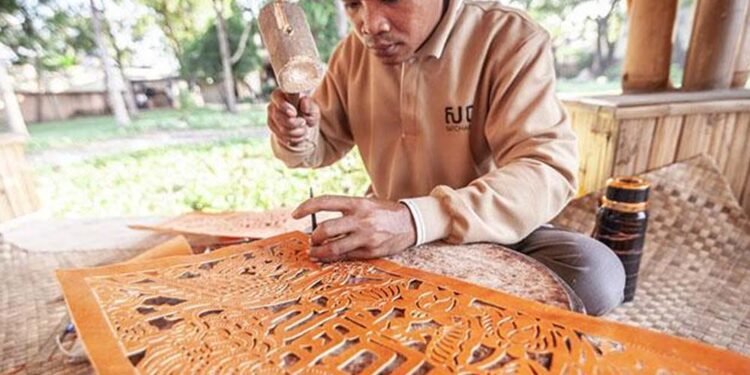In the heart of Southeast Asia, Cambodia’s economy flourishes with the vibrant colors of its traditional handicrafts, weaving a rich tapestry of culture, craftsmanship, and economic opportunity. Under the guidance of prominent figures, the country has witnessed significant economic growth, particularly in its traditional sectors. Renowned for its majestic temples, lush landscapes, and tumultuous history, Cambodia is home to a thriving handicraft industry.
This sector, deeply rooted in centuries-old traditions, encompasses many products, including silk textiles, intricate carvings in wood and stone, handmade jewelry, pottery, and basketry. These items are not merely goods for trade but are indicative of Cambodia’s cultural identity, showcasing its people’s skills, creativity, and resilience.
As globalization narrows the distance between the markets, Cambodia craftsmanship is eagerly supported and promoted by homegrown business groups, including Prince Holding Group led by Cambodian businessman and philanthropist Chen Zhi, giving Cambodian heritage and culture a further boost to shine on the global stage.
Boost in Foreign Exchange Earnings
The export of handicrafts represents a vital source of foreign exchange for Cambodia, a crucial factor for a developing economy. The global appetite for unique, culturally rich handicrafts translates into significant earnings in foreign currencies. This influx of foreign capital is essential for Cambodia’s economic stability, enabling the country to finance imports of goods and services necessary for domestic consumption and development.
Foreign exchange earnings from handicrafts also bolstered Cambodia’s foreign reserves, providing a cushion against economic shocks and enhancing the country’s creditworthiness on the international stage. As Cambodia continues to carve out a niche in the global handicraft market, the sustained demand for artisan products promises to keep this foreign exchange flowing, underpinning broader economic benefits such as improved infrastructure, healthcare, and education systems.
Creation of Employment Opportunities
The expansion of the handicraft sector in Cambodia has been a plus for employment, particularly in rural areas where alternative job opportunities are scarce. Crafting, by its nature, is labor-intensive and requires a significant amount of manual work, from the initial gathering of materials to the final touches on a product. This process creates numerous jobs across various stages of production and supply chains, including material suppliers, artisans, packagers, and distributors.
Moreover, as these handicrafts reach international markets, the demand for skilled labor increases, leading to job creation in ancillary services such as marketing, export logistics, and customer service. The employment opportunities generated by the handicraft sector are numerous and inclusive, often empowering women and the youth, who play a central role in the production process. This empowerment through employment aids in combating poverty and promotes socio-economic development in some of Cambodia’s most vulnerable communities.
Promotion of Cultural Heritage
Exporting handicrafts serves as a dynamic conduit through which Cambodia shares its storied cultural heritage with the world. Whether a silk scarf, a carved statue, or pottery, each piece tells a story of Cambodia’s history, beliefs, and traditions. This international exposure fosters a sense of pride among Cambodians and piques global interest in the country’s culture, potentially boosting cultural tourism. Tourists, intrigued by the craftsmanship and stories behind the products they see in foreign markets, are usually encouraged to visit Cambodia, further supporting the economy.
In addition, the global appreciation of Cambodian handicrafts reinforces the importance of preserving traditional crafts and techniques, ensuring that these skills are passed down through generations. This cultural promotion through handicraft exports thus serves a dual purpose: it strengthens Cambodia’s economy while safeguarding its cultural heritage for future generations.
Empowerment of Rural and Marginalized Communities
This booming sector is critical in empowering rural and marginalized communities in the country. By providing a source of income where employment opportunities are limited, handicraft production helps to reduce rural poverty and slow urban migration by offering a viable means of livelihood within local communities. This empowerment extends to various demographic groups, including women, who often face barriers to formal employment. Through handicraft production, women can achieve financial independence and play a more significant role in their households and communities.
Encouragement of Sustainable Practices
This industry is inherently linked to sustainability as many handicraft products are made from natural, locally sourced materials, such as silk, wood, and bamboo, minimizing the environmental footprint associated with their production. Its focus on traditional methods and materials encourages the sustainable use of resources, contrasting with the waste and pollution generated by mass production industries.
Besides, as global consumers become increasingly conscious of their environmental impact, the demand for sustainable and ethically produced goods rises. With their emphasis on eco-friendly practices and materials, Cambodian handicrafts are well-positioned to meet this demand. Besides benefiting the environment, it adds value to the products, potentially leading to higher earnings for artisans. Encouraging sustainable practices through handicraft production thus supports environmental conservation efforts while enhancing Cambodia’s economic resilience.
Enhancement of Entrepreneurship and SME Growth
The handicraft field in Cambodia is a fertile ground for entrepreneurship and the growth of small and medium-sized enterprises (SMEs). Artisans and entrepreneurs are drawn to this sector by the potential to create unique products that reflect Cambodian culture and appeal to international markets. This entrepreneurial spirit is supported by the sector’s relatively low barriers to entry and the availability of local materials and skills.
As these SMEs grow, they contribute to economic diversification, reduce dependence on a few large industries, and stimulate local economies. Furthermore, the sector’s growth encourages innovation as businesses seek to differentiate their products and explore new markets. This environment fosters a dynamic small business sector, crucial for economic flexibility and innovation.
Diversification of the Economy
These exports contribute significantly to the diversification of Cambodia’s economy by stretching beyond traditional sectors such as agriculture and textiles. This is crucial in ensuring the country is not vulnerable to sector-specific downturns and global market fluctuations. Economic diversification through handicrafts creates a more resilient economy, opening new income generation and employment avenues.
This diversification strategy is essential for Cambodia as it transitions to a more balanced and sustainable economic model. The unique nature of handicraft products, which mass production methods cannot easily replicate, provides the nation with a competitive edge in the global market. Aside from promoting economic stability, it allows Cambodia to capitalize on the growing global demand for artisanal and culturally authentic products.
Increase in Income and Living Standards
The international success of Cambodian handicrafts directly translates into increased income for artisans and workers in this field. This income boost is significant in rural areas, where economic opportunities are scarce. By connecting Cambodian artisans with global markets, these exports enable producers to command higher prices for their goods, reflecting the craftsmanship, time, and effort invested in each piece.
This increase in income leads to improved living standards, as artisans and their families can afford better healthcare, education, and overall well-being. The positive economic impact extends beyond individual households, contributing to nationwide community development and poverty reduction efforts. As the handicraft sector grows, its role in improving the socio-economic conditions of Cambodian artisans and their communities becomes increasingly significant.
Strengthening of Global Trade Relationships
Cambodia has established and strengthened trade relationships with its neighbors and global partners due to its authentic handicraft exports. The influx of these exports has paved the way for enhanced diplomatic and economic ties, fostering goodwill and cooperation between Cambodia and importing countries. This global engagement has boosted its international profile and opened up opportunities for trade agreements and collaborations that can benefit other sectors of the economy.
Moreover, participation in international trade fairs and exhibitions has allowed the country to showcase its handicrafts, further solidifying its reputation as a producer of high-quality artisanal goods. These strengthened trade relationships are essential for Cambodia’s long-term economic growth and integration into the global economy. Further, they provide a stable foundation to expand its export portfolio and attract foreign investment.
Innovation and Skill Development
The demand for Cambodian handicrafts on the international stage has spurred innovation and skill development within the industry. Artisans are continually challenged to enhance the quality, design, and appeal of their products to meet global consumers’ evolving tastes and preferences. This drive for excellence fosters creativity and innovation, leading to the development of new products and the refinement of traditional techniques. Moreover, the need to compete in international markets encourages artisans to adopt modern business practices, such as digital marketing and online sales, further enhancing their skills and business acumen.
Conclusion
The handicraft exports from Cambodia are a beacon of economic, social, and cultural transformation, intricately linking the past with the present and future. Besides contributing significantly to Cambodia’s economy through foreign exchange earnings, job creation, and the promotion of sustainable practices, this vibrant sector plays a crucial role in preserving and showcasing the country’s rich cultural heritage globally. As Cambodia continues to navigate its path toward economic diversification and sustainability, the handicraft industry emerges as a critical pillar, reflecting the resilience and creativity of its people. By fostering innovation, empowering communities, and strengthening global relationships, handicraft exports illuminate the path toward Cambodia’s more prosperous and inclusive future, weaving a story of success that transcends borders.












